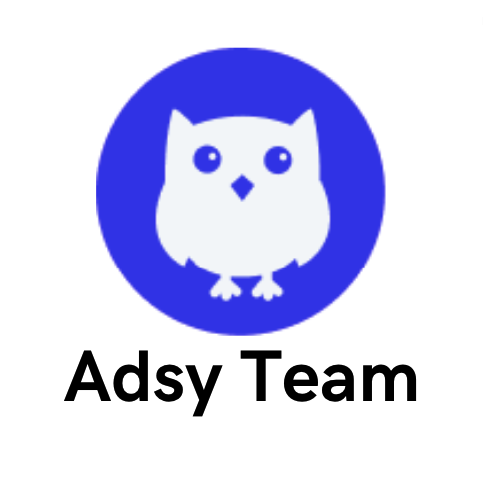SEO Localization or SEO Translation? Discover What's Best for You
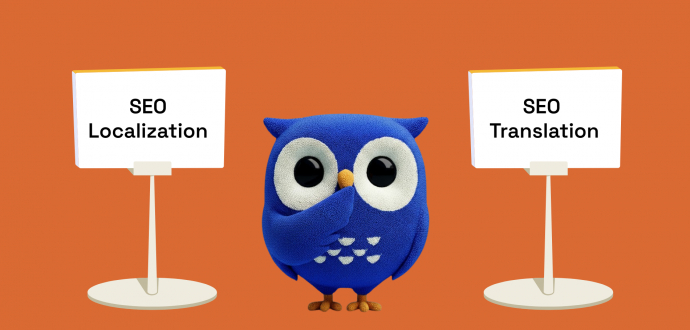
Let's imagine the next situation.
A US skincare brand decides to launch in France. They translate their website into French and think they are ready to launch.
What else is there to be done, right? The translation is accurate, isn't it?
They expect growth, but instead of climbing search engine rankings, their site struggles to appear in local search results. French customers bounce because the messaging on the web page just feels “off”.
French people simply don't talk like that.
Yes, all their copy might be technically correct. But it doesn’t reflect how real locals search. Therefore, they simply… don't. That’s the painful lesson of confusing two similar things: SEO translation and SEO localization.
On paper, these terms sound similar. Both are:
- Tied to search engine optimization.
- Involve creating a website version in a new language.
- Potentially give businesses access to new markets.
But in practice, the difference between them affects your visibility globally. Basically, translation changes your content into a target language; localization adapts it for a target market.
If you’re trying to win over local audiences, relying on a word-to-word translation (and maybe some AI plugins sprinkled on top) isn’t the best idea.
- So, should you avoid translation at all costs? Not really.
- Does every business need a localization strategy? Not necessarily.
We know that it might sound confusing. But it won’t after this guide.
What is SEO translation?
SEO translation refers to converting website content (including your keywords) into another language. Literally. We all know what literal translation means. Finding an exact word equivalent in a foreign language.
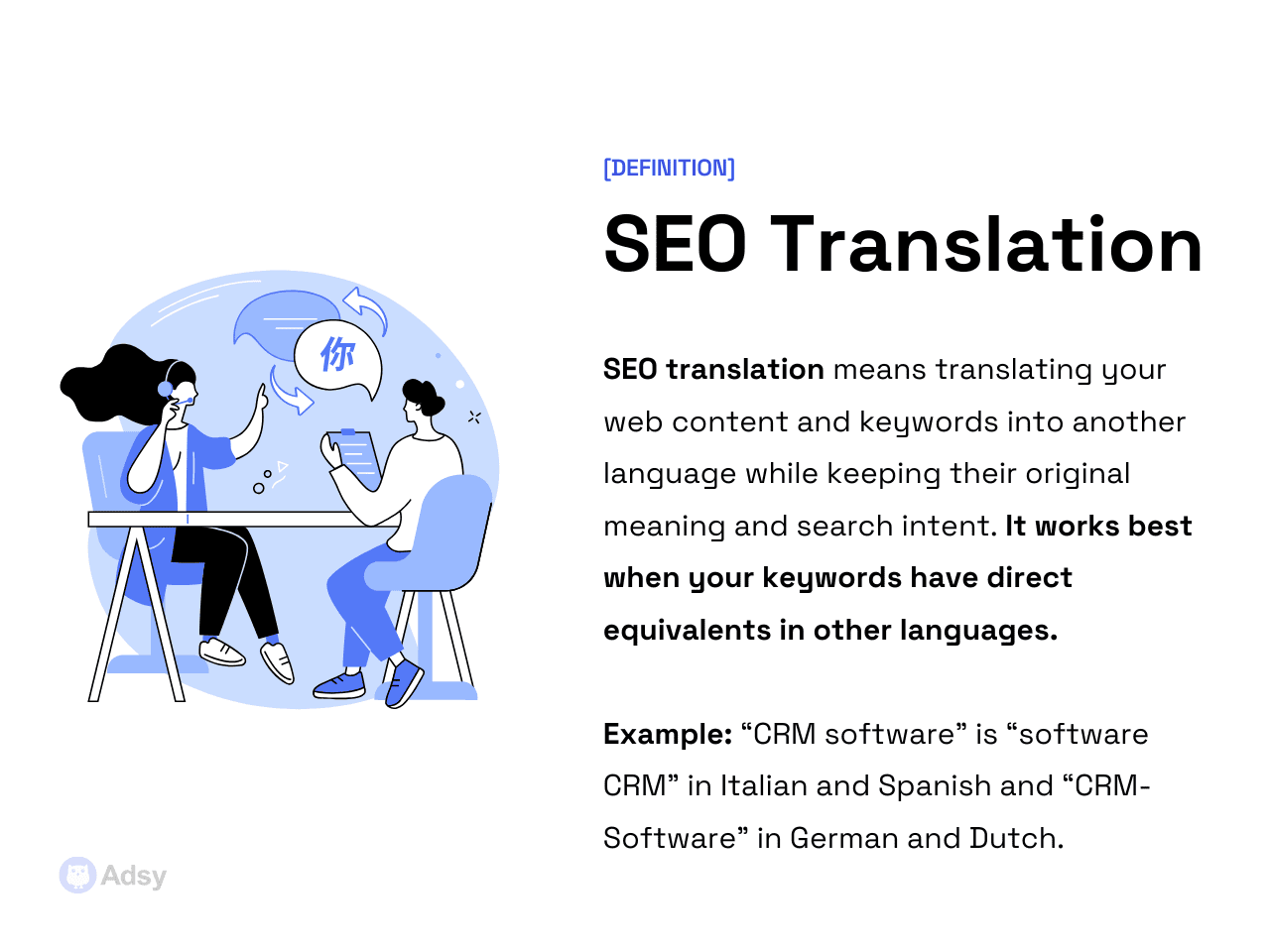
However, if you want to rank well in local search results across the world, you need a bit more than just literal translation. You need cultural context.
For example:
- Your English page says “cheap flights,” and you translate it into French as “vols bon marché.” It’s technically correct, right?
- The only problem you have is a huge one: people in France don’t actually type “vols bon marché” into search engines. They search for “vols pas chers” or “billets d’avion pas chers”.
This is how a quite simple mistake leaves your brand with nothing in a new market.
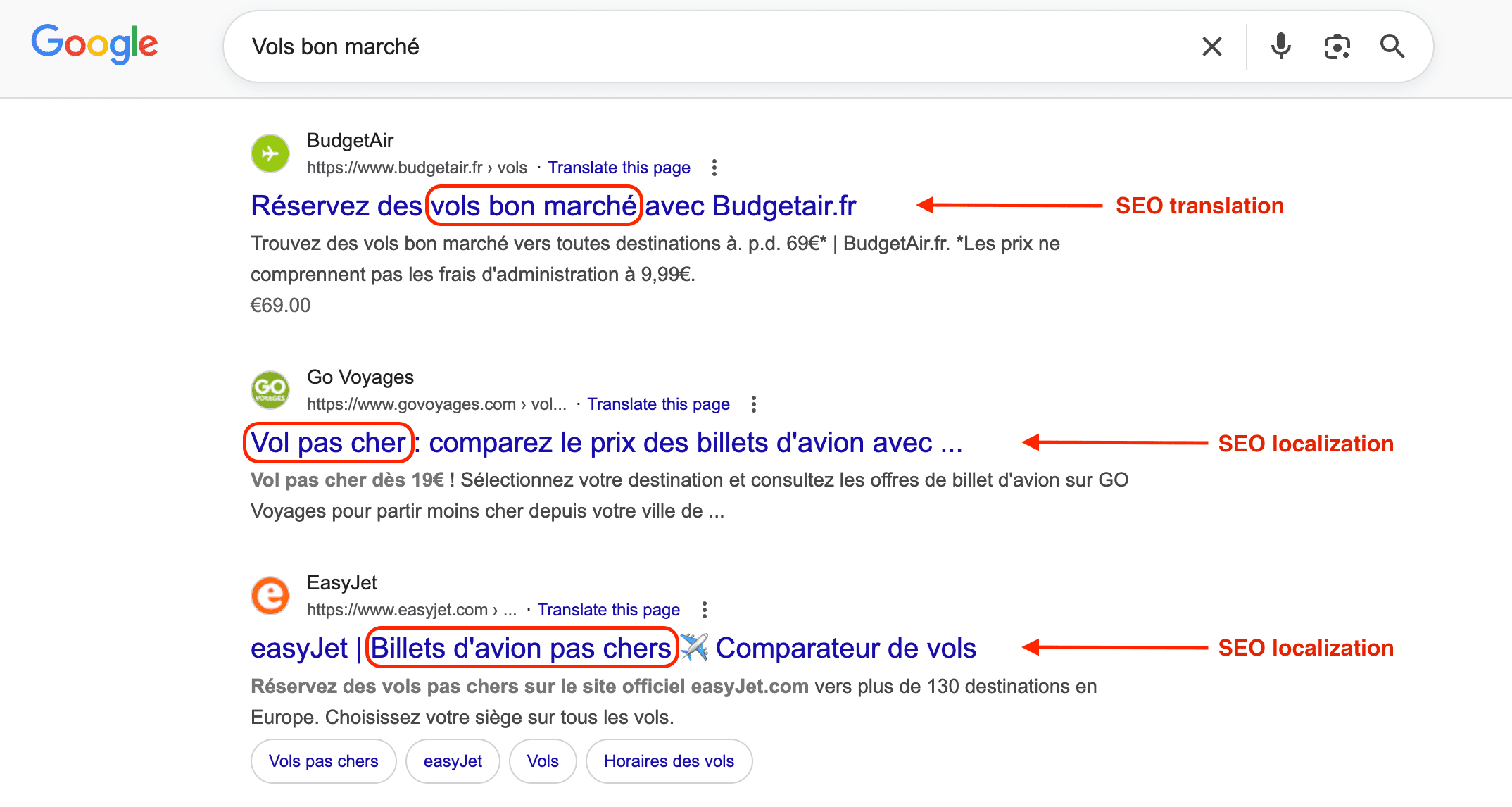
This gap is the biggest weakness of pure translation. The content reads fine to a bilingual reviewer. But when it comes to search visibility, the wrong wording means you won’t capture how users actually search in that target market.
Still, sometimes, SEO translation works just fine because word-to-word equivalents are perfectly native in another language.
- “Weather today” is “Wetter heute” in German (“weather” > “Wetter,” “today” > “heute”).
- “Cheap flights” is “vuelos baratos” in Spanish (“cheap” > “baratos,” “flights” > “baratos”). Just the word order is different in Spanish, but your translation software will handle it.
But… once you see cultural differences come into play, you should generally forget about literal translation. It can mess everything up for you.
What is SEO localization?
SEO localization strategy takes things to the next level, as they say. Its main question is not, “What’s the word-for-word equivalent?” but “How does our target audience search for this concept in their local language, culture, and context?”
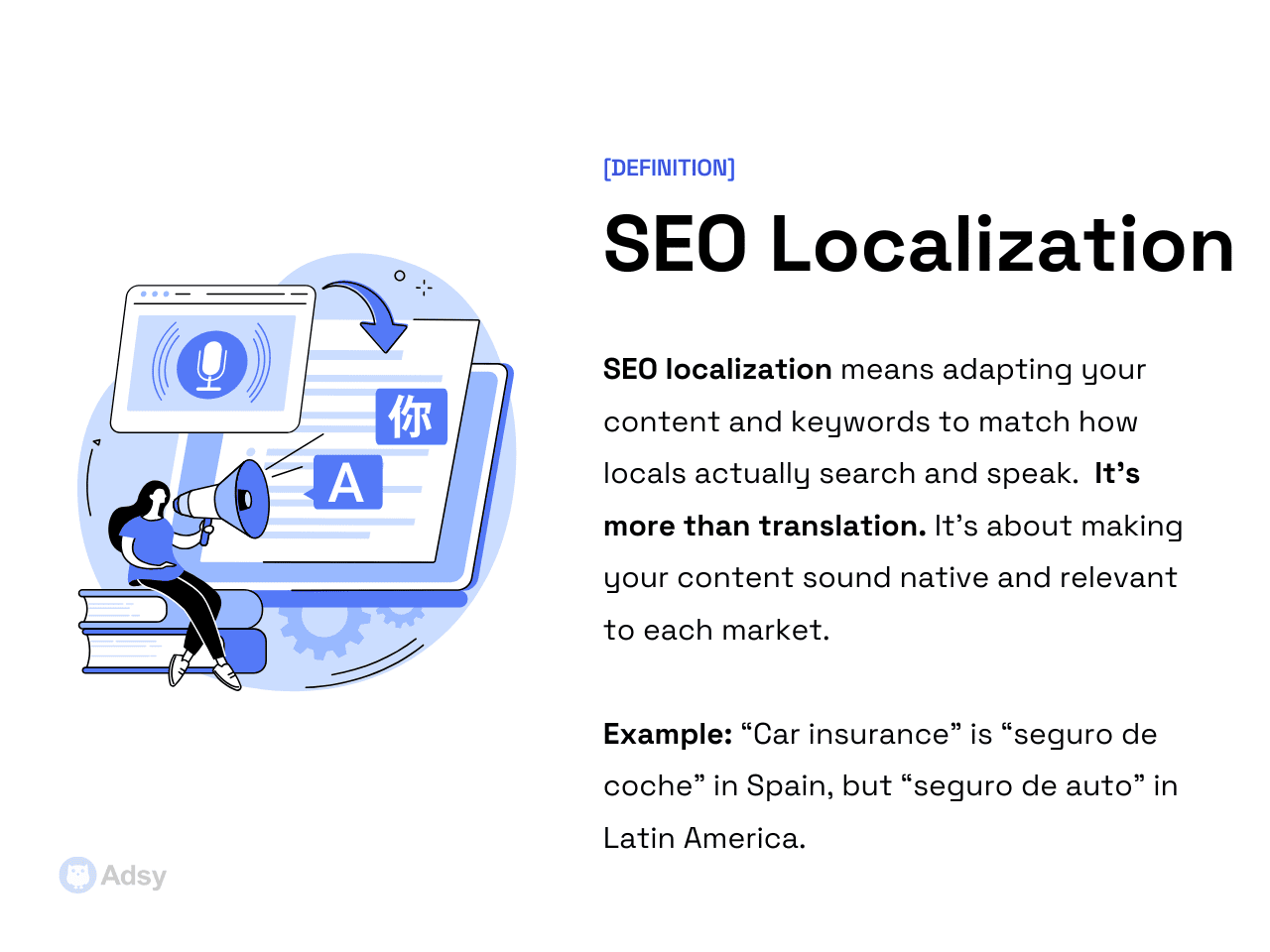
So here, you're not simply switching to another language, like in a literal translation. You are reshaping the message to reflect search intent and cultural nuances. Plus, you are hitting region-specific keywords.
Let's take a look at a super straightforward example:
“Pizza delivery near me.” This is how we would search in English. But if you translate this literally into German, it will sound like a dictionary talking to you:
- No one searches for “Pizza Lieferung in meiner Nähe.” So, it looks weird in the Uber search result below.
- Instead, people would much rather google for something like “pizza bestellen.” That’s what Domino’s Pizza got right.
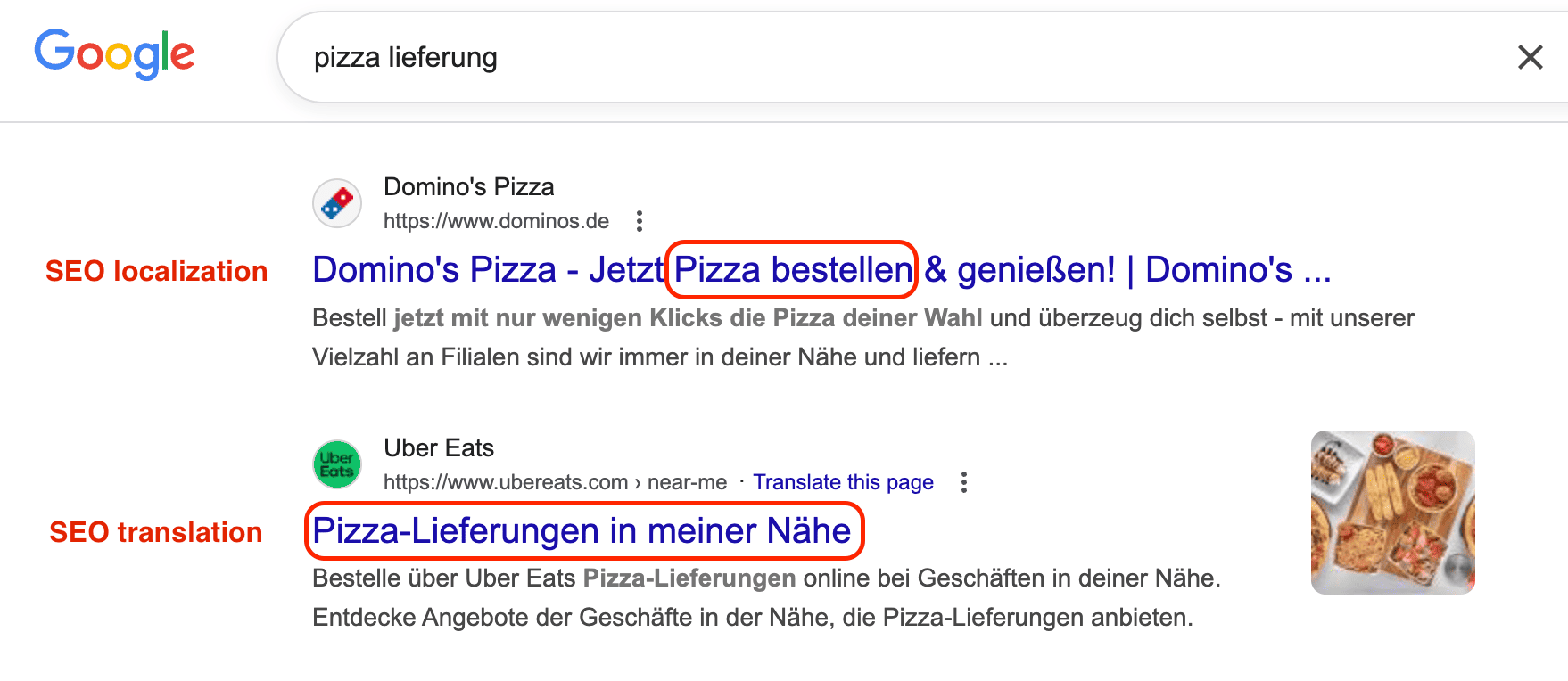
Of course, Germans will understand what you mean. But the issue is that you might not appear for a proper keyword. So, your search visibility in the target language will definitely suffer.
Here is another example that clearly shows that.
For example, if you want to find “car insurance” in Germany, you can google “Auto-Versicherung.” It is a literal translation that works perfectly (“Auto” > “car,” “Versicherung” > “insurance”).
So, if you go for this, you will likely get decent search engine rankings.
But here is a “but.”
Basically, most Germans who want to find a car insurance company search for “Kfz-Versicherung.” “KFZ” is an abbreviation of “Kraftfahrzeug” (motor vehicle).
And this is a widely used abbreviation for anything car-related (e.g., Kfz-Steuer > car tax, Kfz-Kennzeichen > car plate, etc.).
So, if you don’t use “Kfz-Versicherung” in your car insurance website, you won’t rank well in the long run. That’s exactly why most businesses use “Kfz-Versicherung” on their websites. But some also add “Auto-Versicherung” to capture all potential traffic.
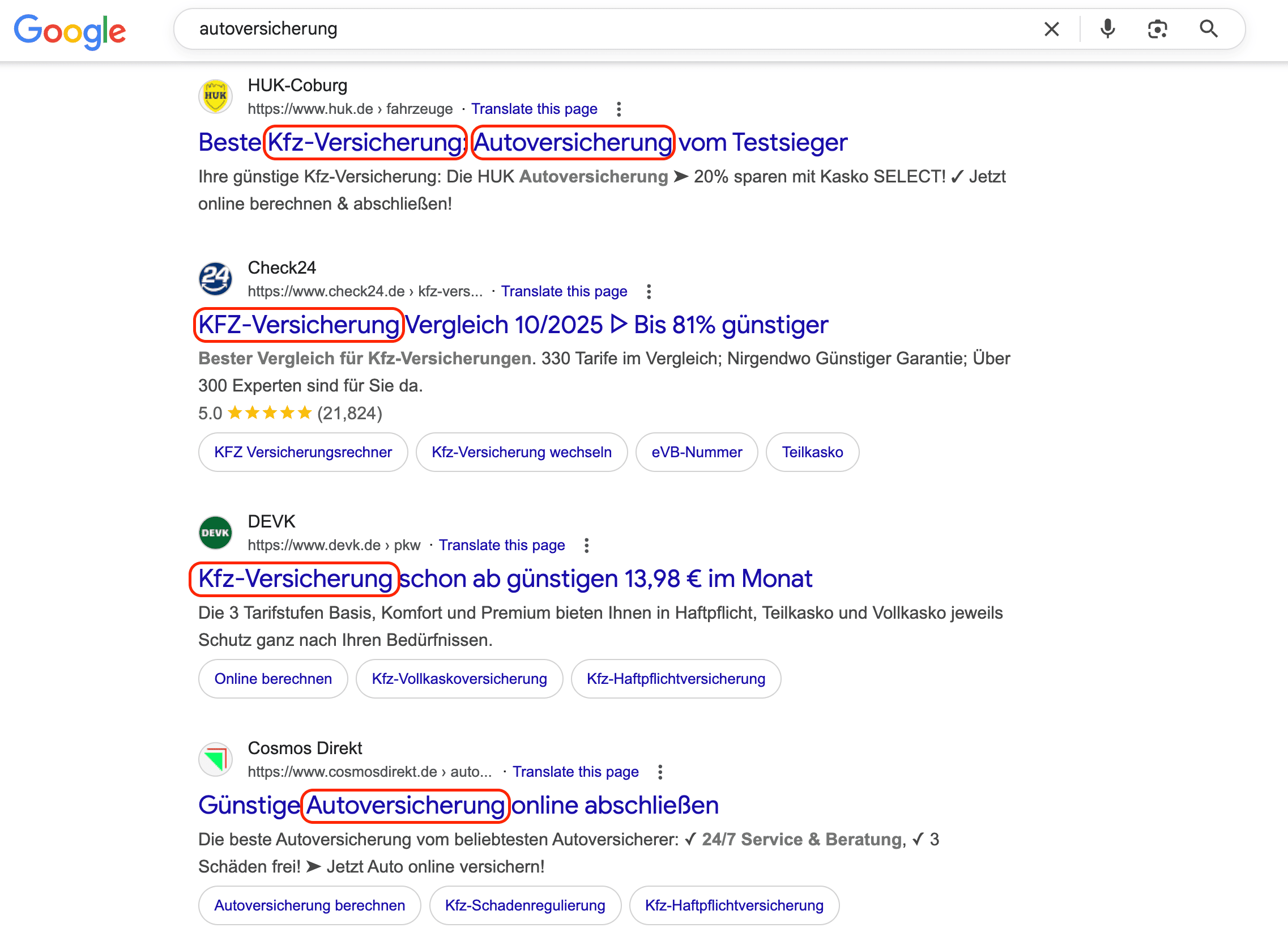
And if you want to translate your website to Spanish, you have to consider the region:
- English: “car insurance”
- Direct Spanish translation: “seguro de coche”
- But in Mexico and most other Latin American countries, people often type “seguro de auto” into search engines.
Basically, localization considers local keywords and how users search in real life. You're not forcing the same content across new markets. But adapt to it.
So, ideally, to build a lasting SEO strategy abroad, you need to do your keyword research in the local language first (more on this later).
Now, let’s recap:
- SEO translation: same content, different language.
- SEO localization: adapted content to the local search behavior and target keywords.
Why the difference matters
It’s easy to assume that as long as your site is translated to the target language, you’ll reach the right people. But search engines (and human users) don’t work that way.
The real difference between translation and localization shows up not in the words themselves, but in your bottom line:
- Get it right, and your site ranks higher, attracting organic traffic. And it also has much higher chances of converting your visitors into buyers.
- Get it wrong, and you either show up for the wrong keywords (getting irrelevant traffic, a high bounce rate, and no conversions). Or don’t show up at all for your local audience.
Let’s look at what happens when brands choose the right approach. It is really interesting how some of the world’s biggest companies avoid this trap.
Great examples
Nike
Nike knows better than to just translate “running shoes” into “zapatos para correr” on their Spanish site version. That’s a literal translation, but not how people actually search.
Through multilingual keyword research, Nike discovers that, in reality, Spanish users search for “zapatillas de running”:
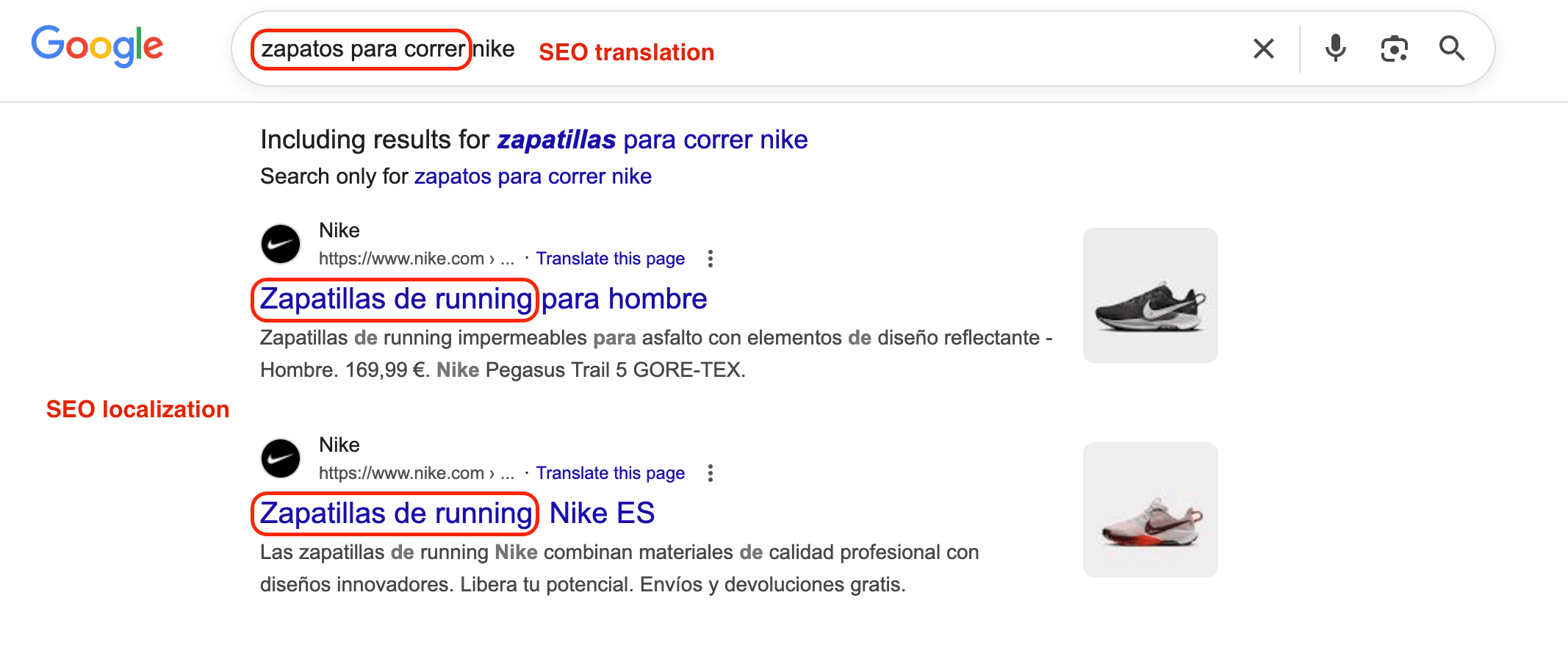
… or “zapatillas deportivas” if they’re searching for something broader like sneakers:

So, Nike did not rely on direct translation, which would not help their Spanish SEO strategy and audience.
Nike reshaped its content: product names, currency, meta tags, and landing pages. All of them use the terms that Spanish users expect.
Of course, Nike also has a localized marketing strategy that goes beyond just their SEO and website. They:
- Collaborate with local influencers.
- Create culturally relevant campaigns.
- And promote the products that make more sense for this target market.
As a result, Nike ranks at the top of Spanish search engines for most of their target terms. It captures local search preferences and converts organic traffic into sales.
That’s an SEO localization strategy done right.
Airbnb
Airbnb could have translated “vacation rentals” into “affitti di vacanza” for the Italian audience. It’s grammatically correct, right? Well, yes, “affitti” > “rentals,” “vacanza” > “vacation”.
But localization is trickier than that.
Do people in Italy often use this query in their searches? Nuh. They use “case vacanze,” which means “vacation houses.”
Now, guess what term has Airbnb used? Exactly!

Airbnb localized its Italian SEO pages by adapting keywords and phrases for the target market instead of using a “one-language-fits-all” approach.
On top of that, they localized imagery, reviews, and call-to-action. After all, these are a part of the copy, too. They have to match local context and cultural nuances.
And of course, they did it in many markets, not just the Italian one. This allowed Airbnb to dominate organic traffic internationally. They built trust with local audiences through the simplest thing: really speaking their language, as it is.
IKEA
IKEA is famous for its subtle attention to detail. Does their SEO strategy reflect that, too? Let’s see.
In the US, they advertise “comforters.”
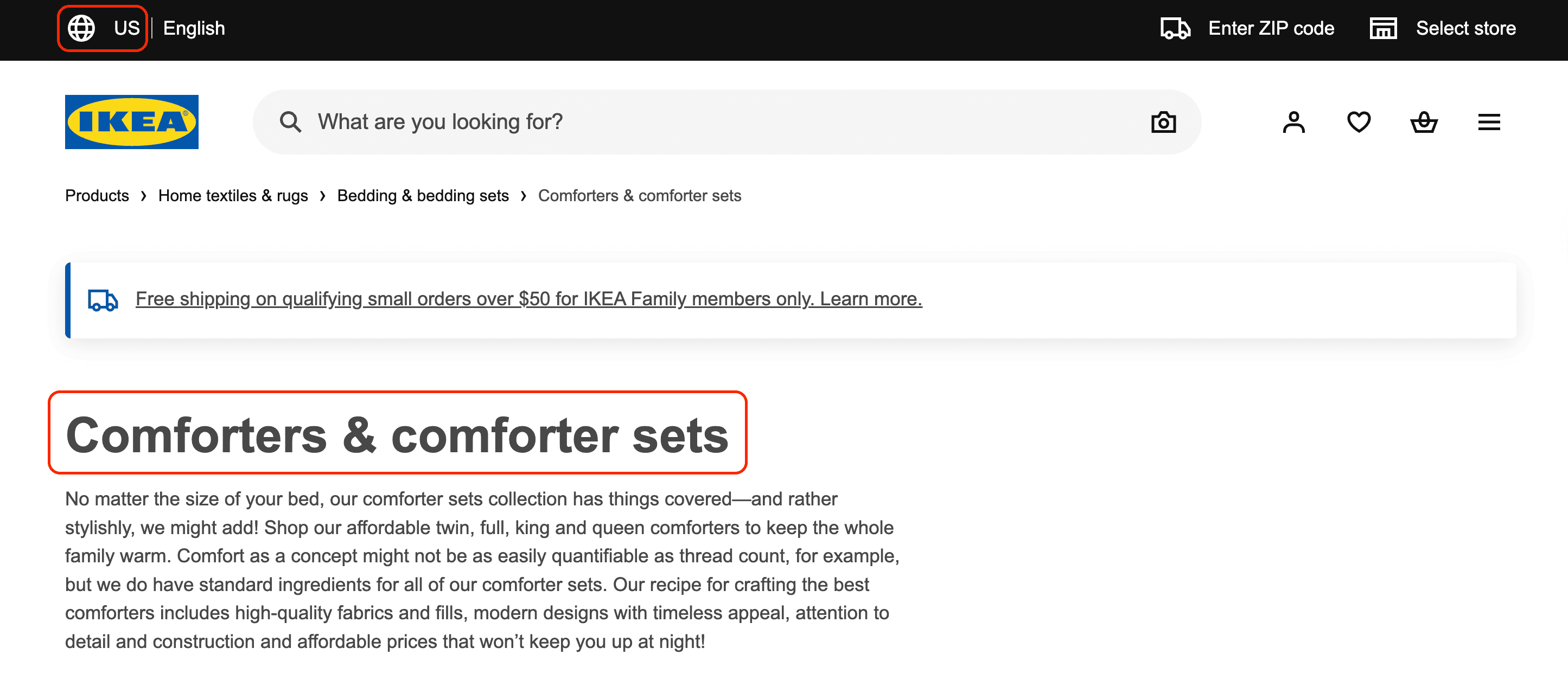
Source: IKEA
But what about the UK? It's the same language after all.
While the language is the same, the “comforters” is typically something people in the US and Canada use. But in the UK, EU countries, and some other regions, people use a duvet and a duvet cover.
So, on the Great Britain IKEA website, you won’t even find a category that says “comforters.” You’ll have "duvets," "bed linen," "bedspreads," and tons of other things, but no comforters whatsoever.

Source: IKEA
And these are the bedding categories in the US (with comforters included, of course):

Source: IKEA
So, obviously, it’s far from just translation. Their SEO strategy was clearly built on strong keyword research with localized keywords for each region.
Coca-Cola
Everyone knows about the “Share a Coke” campaign. But not many think about how well-adapted it was to local audiences.
In every country, Coca-Cola used a bunch of local names on its bottles. And that's what made everyone super excited about this campaign.
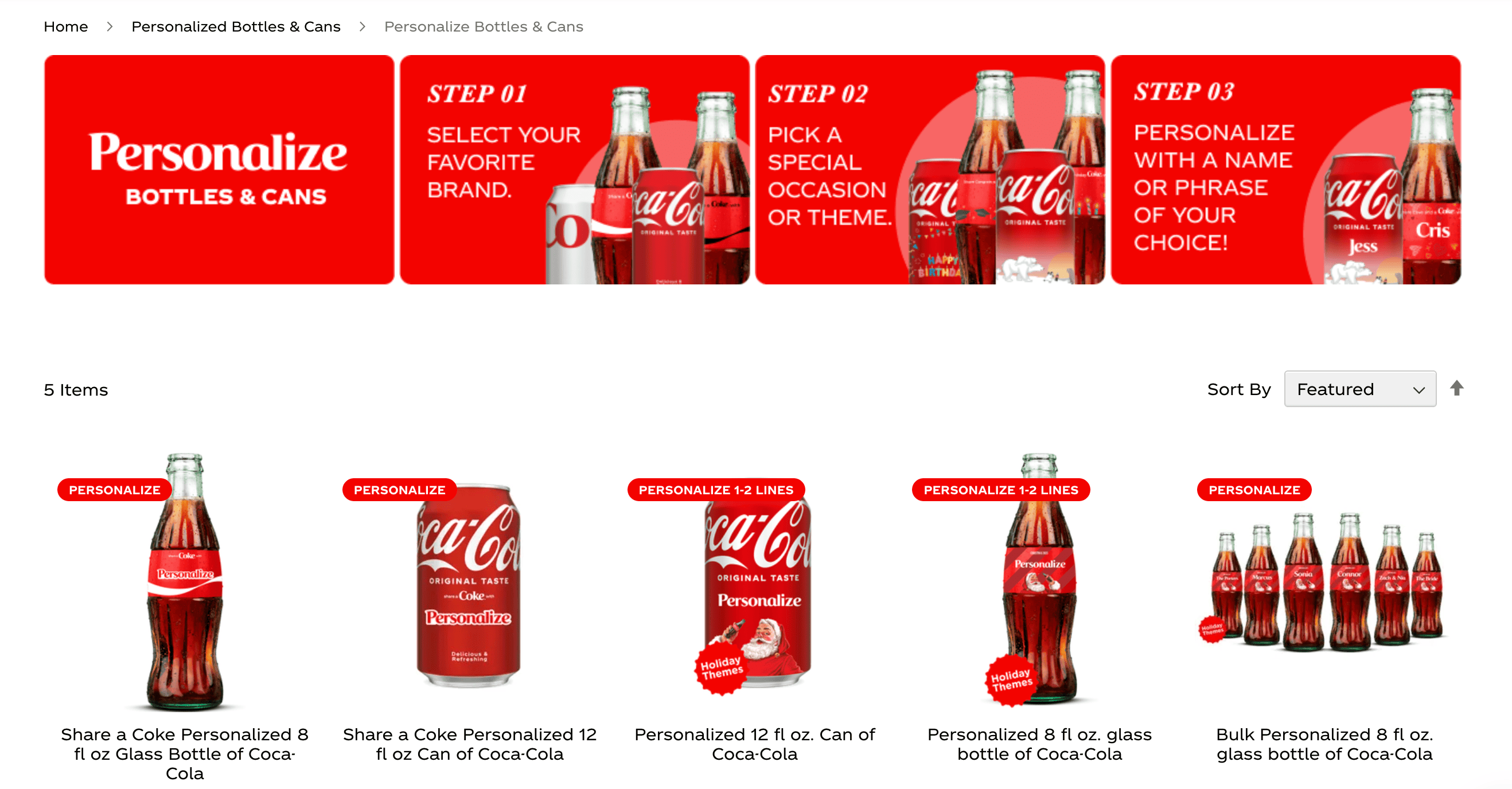
Source: Coca-Cola
However, in China, it was complicated to use names. First of all, they don’t use the Latin alphabet. And secondly, each name can be written with dozens of different characters, creating thousands of variations.
So, instead, Coca-Cola used terms like “bro,” “roommate,” or “crush”.
That's a really good example of localization. And that's what boosted Coca-Cola’s local visibility. Or, we should probably say re-boosted, because they were already popular.
Netflix
Netflix is another company that understands that success goes beyond just SEO translation. In every country they expand to (over 190 right now), they focus on local language and content for that place.
They also add local subtitles, dubbing, and take into consideration the local preferences of the people. To make it work from business and marketing perspectives, they also do A/B tests to figure out which localization tactics are the most effective.
This is the Netflix homepage in the US:
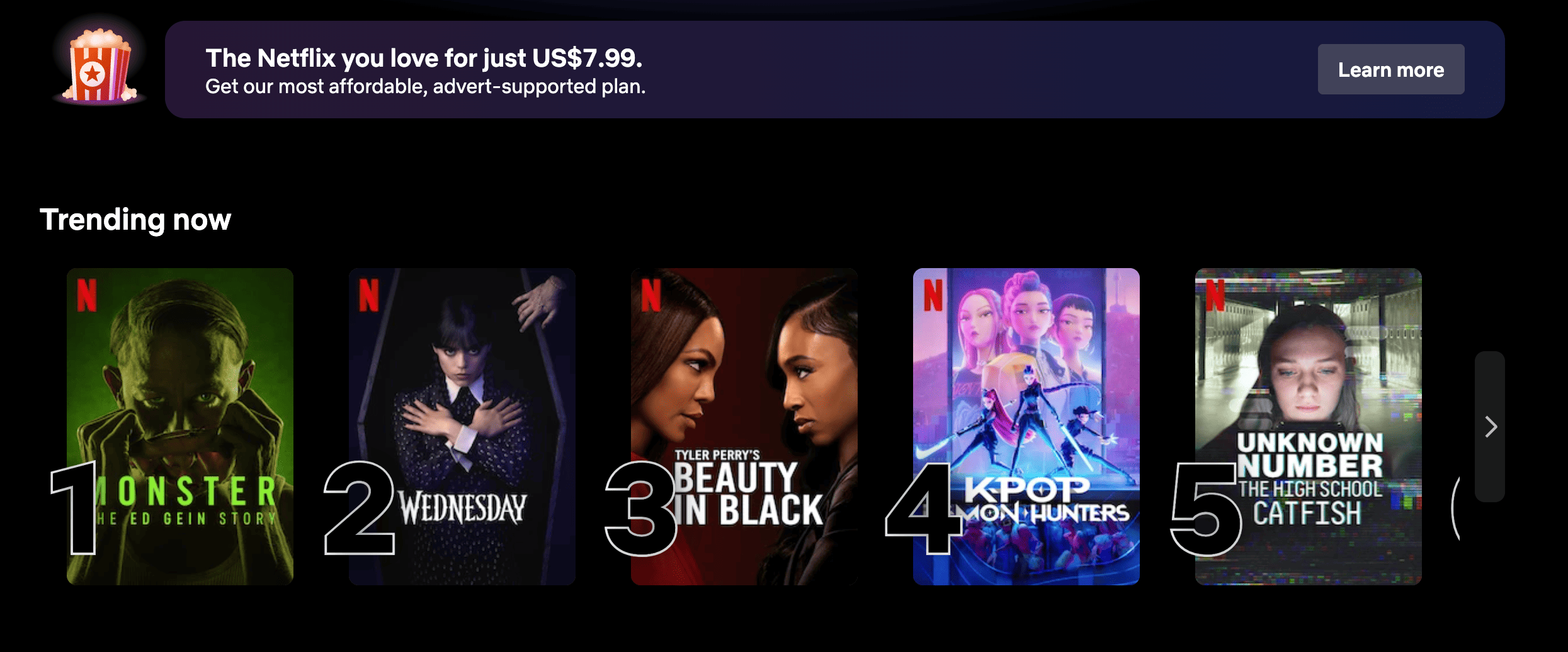
Source: Netflix
And this is in France, for example:

Source: Netflix
Today, not only can users find internationally popular movies on Netflix, but there is also original local content that reflects the culture. It is no wonder their revenue keeps increasing.
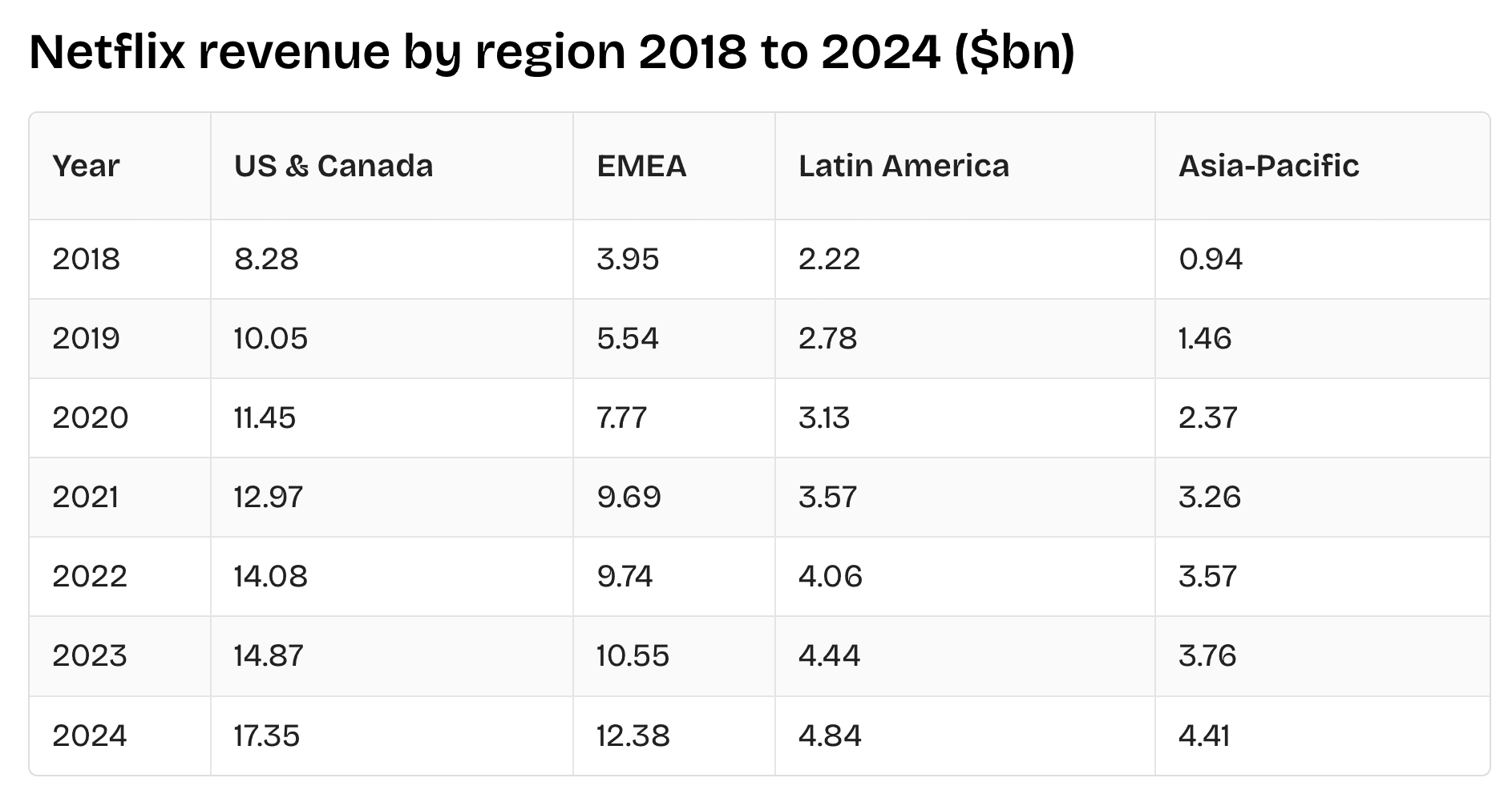
Source: Business of Apps
So, no matter what you think of Netflix, their multilingual SEO strategy (and marketing strategy in general) works.
Lost in translation
And no, we aren’t talking about Sofia Coppola’s movie.

Source: Amazon
The thing is that translated and localized content isn’t the same in most cases. And sometimes, translation turns international market expansion into a complete disaster.
Not all the real-life examples are as good as what we’ve seen above.
There are many situations where famous brands simply messed up due to a lack of research. Whether it was keyword research or an understanding of the cultural differences.
HSBC
HSBC’s global slogan, “Assume Nothing,” was translated into multiple languages. It might look good enough for the naked eye, but in many countries, it didn’t turn out well. It was a bewildering… “Do Nothing.”
Huh? What's that supposed to mean?
There is no local audience that would appreciate such a brand message from a bank.
The backlash forced HSBC to spend $10 million rebranding to the safer slogan: “The world’s private bank.”
This is an example of how literal translation (without localization) could damage more than just search rankings, but also a brand’s reputation.

Source: Facebook
KFC
Even though the internet is full of articles with this example, we couldn’t verify that it actually happened. There are no available records of it or anything that proves it in any way.
But even if this didn’t really happen, it is a great reminder for all of us that the translation process should really be taken seriously.
So, the legend has it that KFC’s US slogan “Finger Lickin’ Good” was once literally translated in China as “Eat Your Fingers Off.”
Supposedly, that campaign failed, and visibility around the brand tanked. Until they re-localized messaging, making it relevant to the Chinese local market.

Source: Facebook
Parker
Another example that we couldn’t verify but that still gives a great lesson is the Parker Penn's translation mix-up in Mexico. As many sources online claim, when this well-known manufacturer of high-quality pens expanded to Mexico, they messed up with the slogan.
They chose the following one: "It won't leak in your pocket and embarrass you!" In English, it simply highlights the fact that the pen is leak-proof, highlighting its quality. But in Mexico, it translated into: "It won't leak in your pocket, and make you pregnant!"
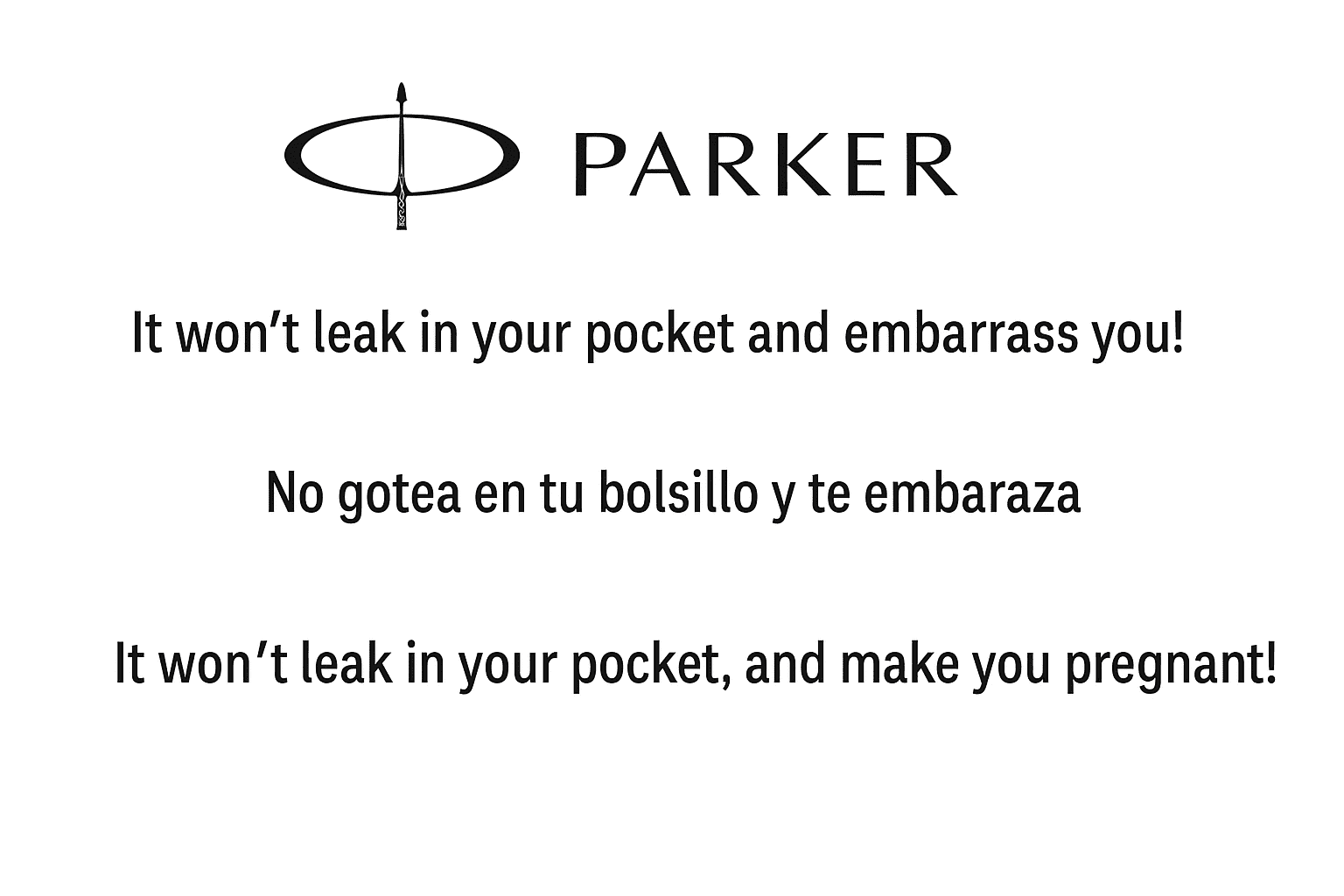
Again, even if it’s more of an anecdote by now, this is something that can really happen. Especially when you just use some automated translation instead of building a proper localization strategy.
When does SEO translation work best?
After all these examples, it's important to understand that SEO translation is not your enemy. There are exceptions, and it helps when you are just aware of them.
Overall, these are the general use cases where translation works well:
- If you’re just testing the waters in some market, and you use translation as your first step.
- When your industry uses standardized international terminology.
- When many of your keywords have a one-to-one equivalent in other languages, and in our globalised world, it happens a lot.
For example, SaaS companies often succeed with translation for one simple reason. Because “cloud storage” or “CRM software” translates into other languages without confusion.
You don't have to tweak your keywords much. They are already recognizable across the globe (literally).
But in consumer-facing industries (fashion, food, travel, e-commerce), direct translation typically won't work. People use slang, nicknames, or culturally influenced phrases.
And... that’s where the limits of translation become painfully clear.
Or just cringy:)
SEO translation and localization: How to spot what you need?
So now that we’ve seen what happens when brands choose the wrong path, what’s the natural question? Right.
How do you know whether you need simple SEO translation or a full SEO localization strategy?
As it usually is with pretty much any complex matter, the answer would be "it depends”.
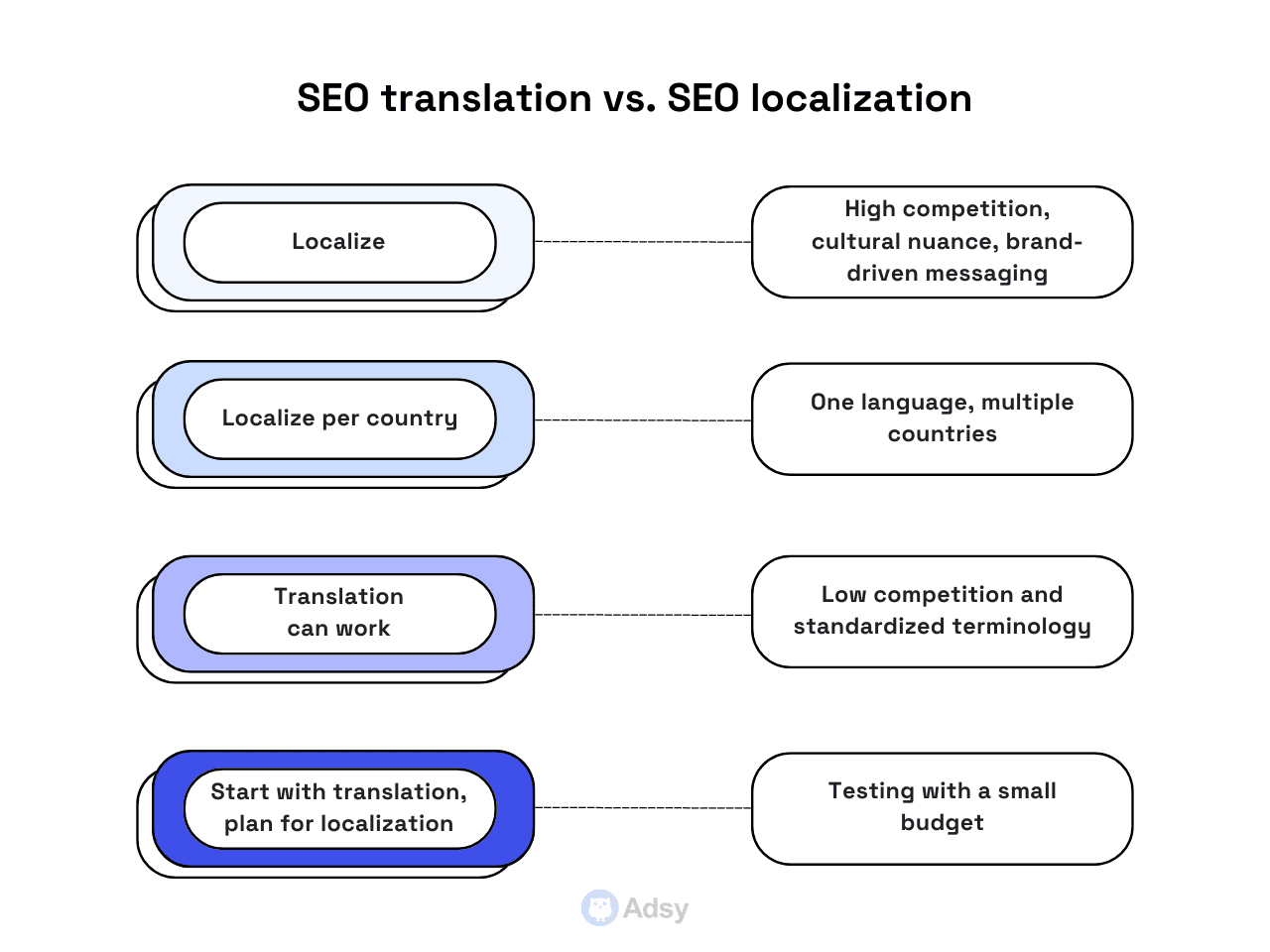
Entering new markets with different slang or culture: Localization
If you’re moving into a market where people use unique slang or search queries, localization is a safer bet.
Again, let’s glance at the Airbnb example. In Italy, “vacation rentals” became “case vacanze”. If they had relied on literal translation, they would have been almost invisible.
Rule of thumb: The more cultural variation in everyday language, the more you need localization.
Standardized, technical, or professional fields: Translation works
Not every industry demands localization, as we said before. Software, SaaS, or medical device terms are most often standardized across languages.
For example, “CRM software” is often used without any translation (at least the “CRM” part). It means the same thing in most markets:
- “Software CRM” in Italian and Spanish.
- “CRM-Software” in German.
- “CRM-software” in Dutch.
In these cases, translation can be enough to get you started.
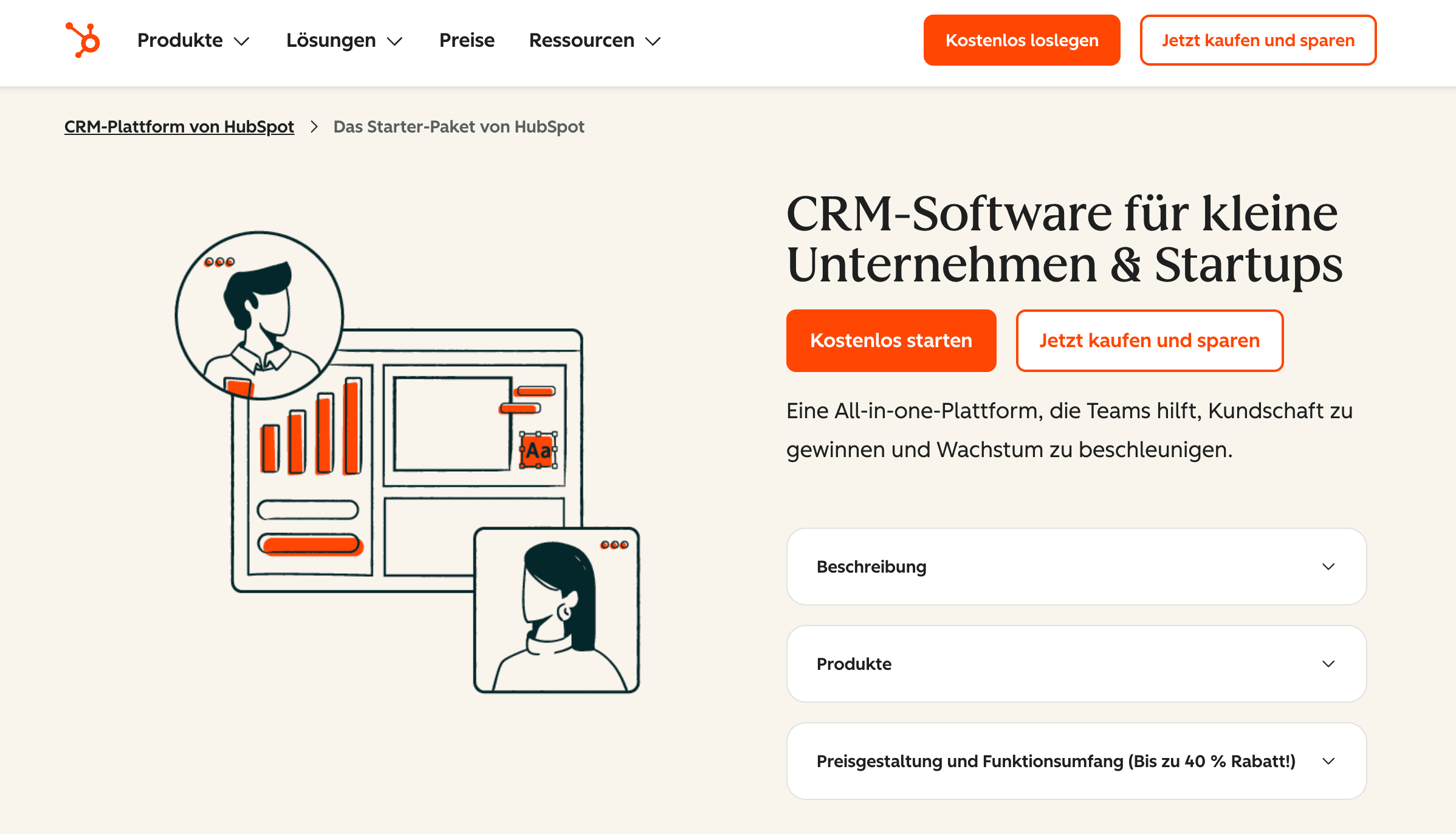
Source: Hubspot
Rule of thumb: If your industry uses universal terminology, you might save money by sticking to translation first.
Expanding across multiple countries with the same language: Localization per country
Here’s where many businesses make mistakes. Spanish is definitely not the same in Mexico, Argentina, and Spain. English isn’t always the same in the US, UK, and Australia.
Rule of thumb: Even within the same language, localize per country if you want to maximize your visibility in each region.
Budget constraints: Start with translation, upgrade later
If you’re a small business or testing a market for the first time, you may not have the resources for full localization. In that case, start with translation to establish a presence, then analyze performance.
If traffic is weak or conversions stay low, it’s a signal to invest in localization.
Rule of thumb: Translation can be a first step, but rarely the last.
Highly competitive industries: Localization (mostly)
If you’re in fashion, travel, food delivery, or fitness apps, chances are your competitors are already investing in search engine optimization. Literal translation won’t help you here, and we are saying that with like 99.9% confidence.
Nike localized it to “zapatillas de running” because that’s what Spanish runners actually typed. That difference is why they rank and why they did not end up behind smarter competitors.
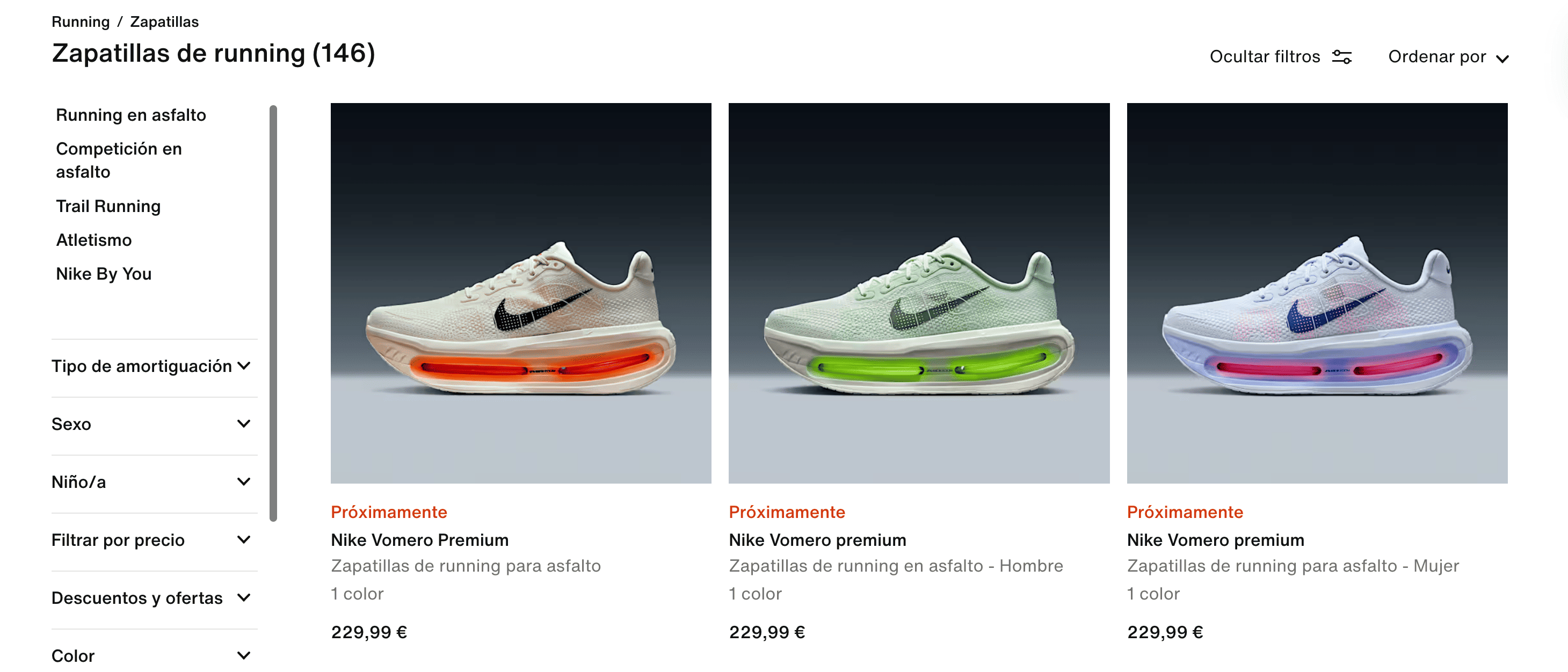
Source: Nike
Rule of thumb: If the market is already competitive and other brands are heavily invested in optimization, localization is a must.
When it comes to content creation in a new market, the point is not to treat translation and localization as rivals, but as tools.
Sometimes, you need a quick, direct translation. Sometimes, you need a culturally tuned localization strategy. The smartest brands mix both depending on context.
Common mistakes businesses make
Even after understanding the difference between translation and localization, companies make mistakes. They cost them rankings, traffic, and credibility.
These mistakes usually come from underestimating how complex multilingual SEO really is. Let’s walk through the most common ones.
1. Assuming one translation covers all Spanish-speaking countries
This is probably one of the most common mistakes. Spanish is the fourth most spoken language in the world. So, it’s absolutely logical that many businesses add a Spanish SEO translation to their website.
But Spanish is spoken in over 20 countries. And the words people use vary. And often, they vary a lot.
- In Latin America, people say “celular” for mobile phones. In Spain, it’s “móvil.”
- For “car,” Latin Americans type “auto” or “carro”, while Spaniards search “coche.”
- And when searching for a computer, people in Spain look for “ordenador,” while in Latin America they type “computadora.”
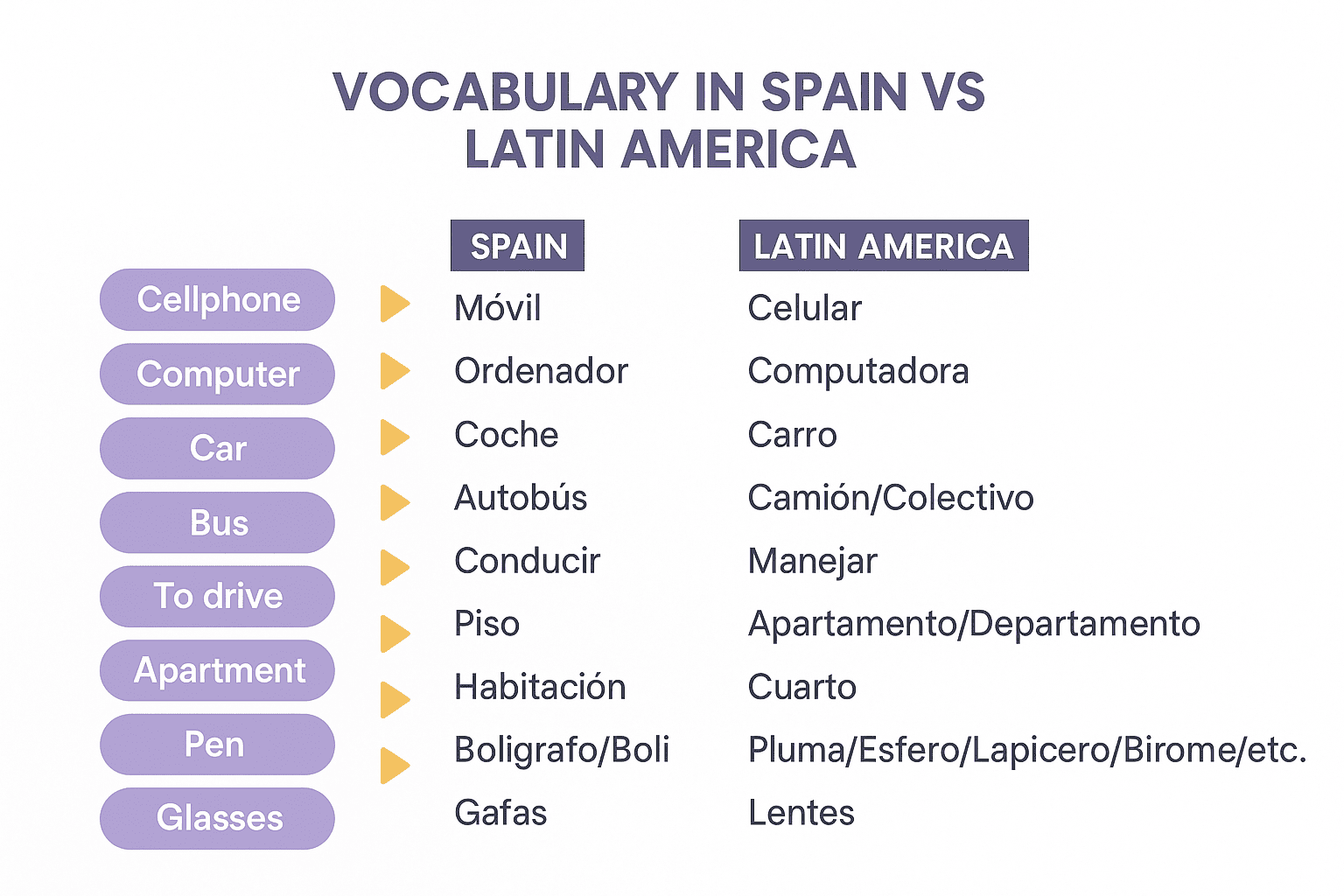
A business that rolls out one “global Spanish” translation ends up being half relevant everywhere. But all they need are culturally appropriate versions.
So, if you want to add Spanish language to your website and reach the whole Spanish-speaking market, you’ll need proper Spanish SEO localization, not just translation.
2. Ignoring local search engines
Google is not the only search engine out there. There are multiple Google alternatives. And it’s vital to know about them if you want to get more viability in international markets:
- Baidu is China's Google.
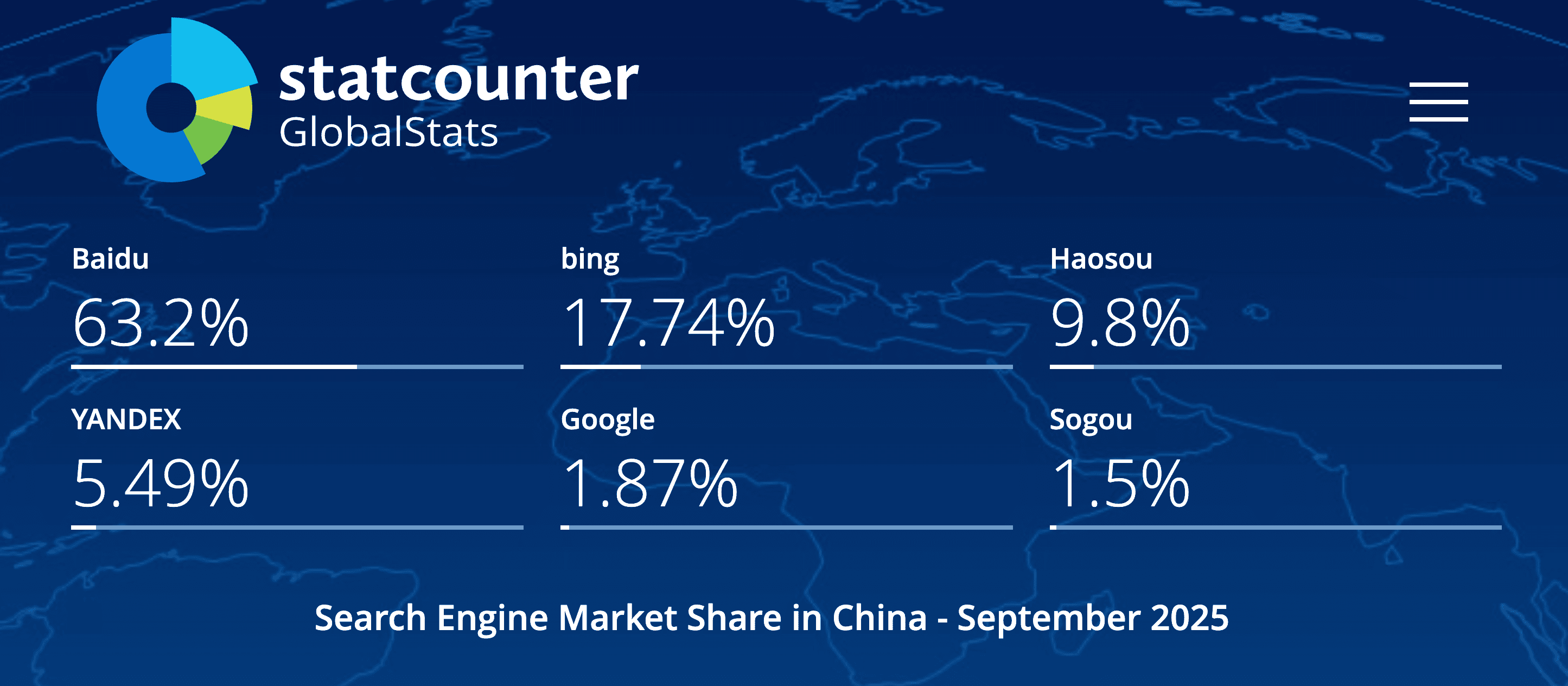
Source: Statcounter
- Naver is one of the leaders in South Korea.
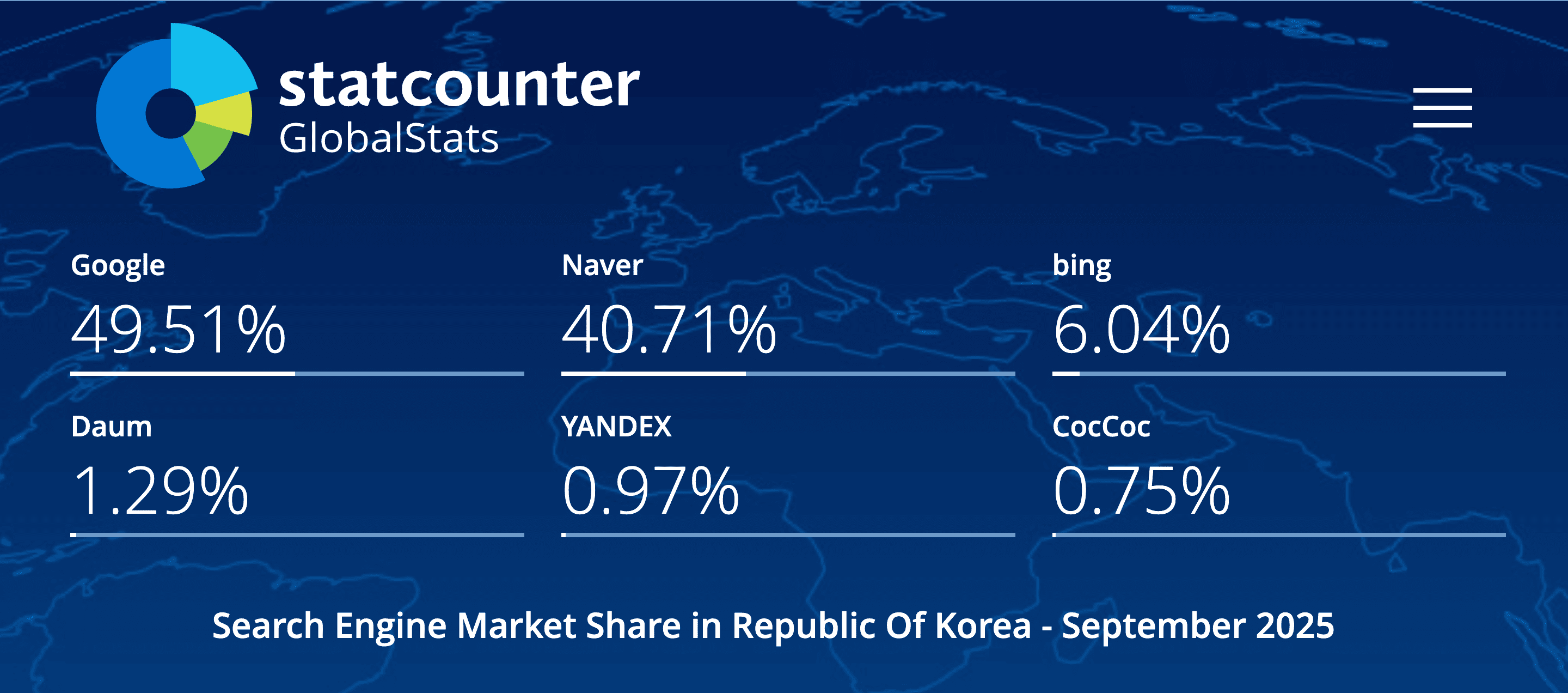
Source: Statcounter
Each platform has its own search ranking factors and quirks. For example, Baidu favors simplified Chinese and faster loading speeds (even more than Google). Sometimes, even government approvals are required for content.
So, finding relevant keywords for your local markets alone might not be enough. You have to be where your audience is.
If you optimize only for Google, you might miss tons of potential traffic.
Your site might look perfect on Google, but remain invisible in the local search engine most people actually use.
3. Forgetting technical SEO basics
When we talk about SEO translation and localization, it might seem like it’s all about words and their interpretation. But it’s far from that. It’s also about the technical SEO foundation of your site. Don't forget about:
- Missing hreflang tags: Without them, Google can’t tell which version of your site to show users in France vs. Canada. That leads to duplicate content issues and poor rankings.
- Duplicate content across markets: If you use the same English page for the UK and US without adaptation, Google may penalize or de-prioritize one.
- Incorrect URL structures: A site.com/fr/ setup signals French content, but site.com/page?lang=fr confuses search engines.
Even perfectly localized copy won’t rank if your technical optimization is off. Just don't forget about these “ABC rules”.
4. Over-reliance on machine translation
We’re getting used to relying on tech and machines more than ever. And translation is not an exception.
Google Translate, DeepL, AI-powered engines, or website translation plugins like Weglot might look like good translators.
They might be truly great at translating. But they are also prone to miss cultural nuances and search intent. They simply can't do the necessary research.
In case you skipped the part with all the examples above, here is another one:
“Organic skincare” translates literally into German as “organische Hautpflege.” So, technically, this translation is correct. And that's what you can get in any automated translator out there.
However, it's unnatural. Very few people would look for “organische Hautpflege.” The real keyword Germans use is “Naturkosmetik.”

5. Forgetting to localize beyond keywords
Localization is not only about replacing words in headings and copy. It’s also important to adapt other aspects:
- Meta titles and meta descriptions. They’re huge for the site’s ranking and CTR in search results.
- Imagery and design. Imagine you’re a real estate company, showing American Dream houses with white fences in Japan (especially big cities). It makes no sense, as most people there live in tiny apartments.
- Calls-to-action. “Buy Now” doesn’t work everywhere. In France, “Achetez dès maintenant” feels pushy; “Découvrez nos produits” (Discover our products) works much better.
If you think that we exaggerate a bit with all these tiny details, just take a look at this.
Here is the US Sephora website and its CTAs:

Source: Sephora
And this is the same Sephora in France:
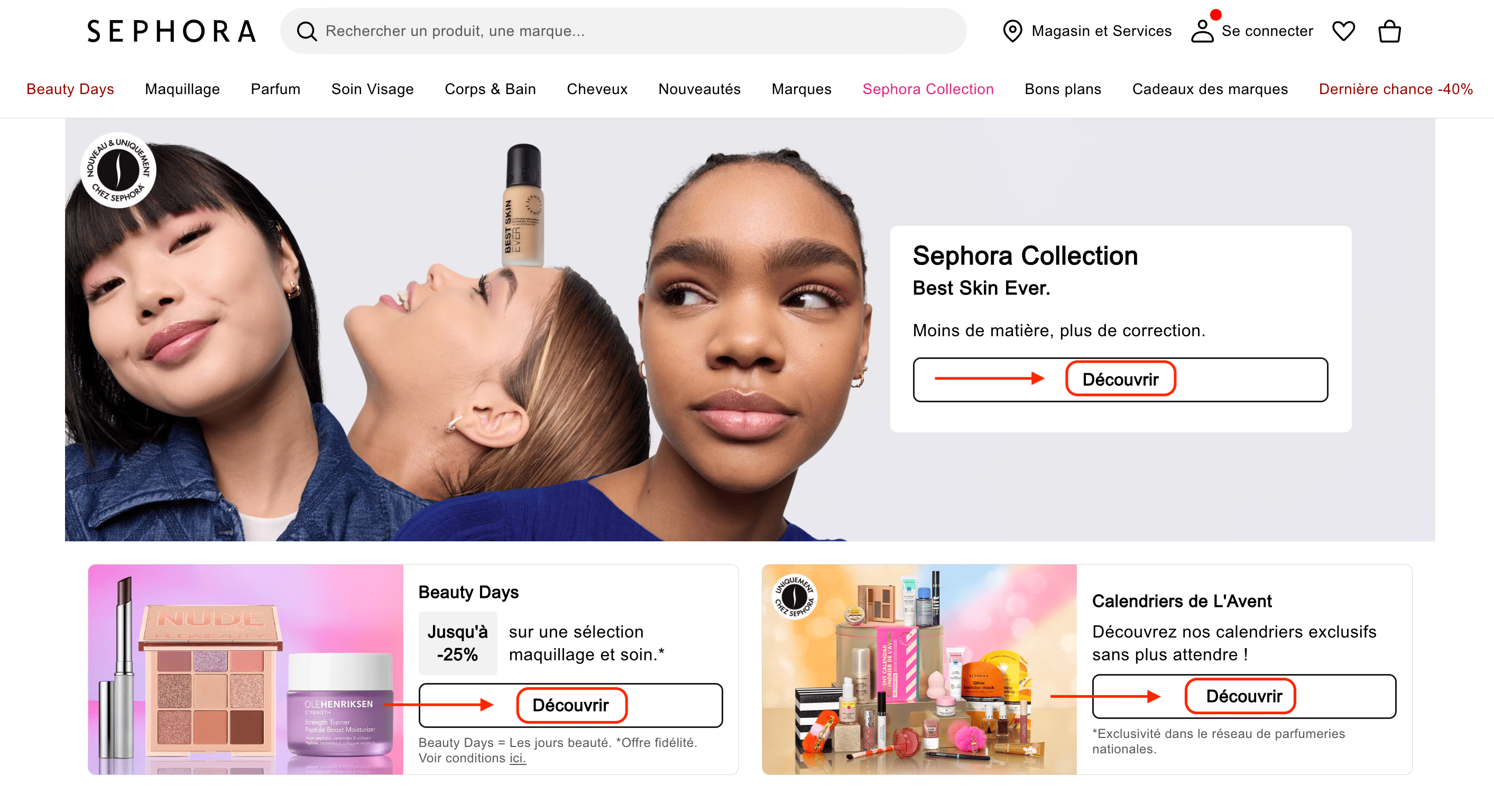
Source: Sephora
Well, voilà:)
So, again, finding relevant keywords for local SEO is a must. But even if users find your page, they might not convert because your website feels off. And, therefore, people can't trust something that pretends to be local but feels foreign.
6. Not adding local backlinks
Search engine optimization is not just about creating content that matches search intent. In international SEO, search engines evaluate local search behavior. Plus, they look for the authority signals that support it.
One of the tactics that everyone keeps forgetting about is building local backlinks.
Is it okay if your French website is supported only by US backlinks? Ermmmm… no. Google won’t see it as relevant in France, and can you blame it for that? It is actually seeing things right.
It’s great if your existing links are powerful and high-authority. But if you have no relevant backlinks in your new target markets, search engines won’t prioritize your content in those locations.
How can you localize?
There’s no one formula for implementing localization. The right approach depends on your size, budget, and target markets.
But the goal always remains the same: make sure your content aligns with local search behavior so that your SEO performance isn’t held back.
For small businesses
If you’re a small business, a startup, or a company that’s just testing a particular location, you don’t need to reinvent the wheel:
- Weglot can help with quick language rollouts.
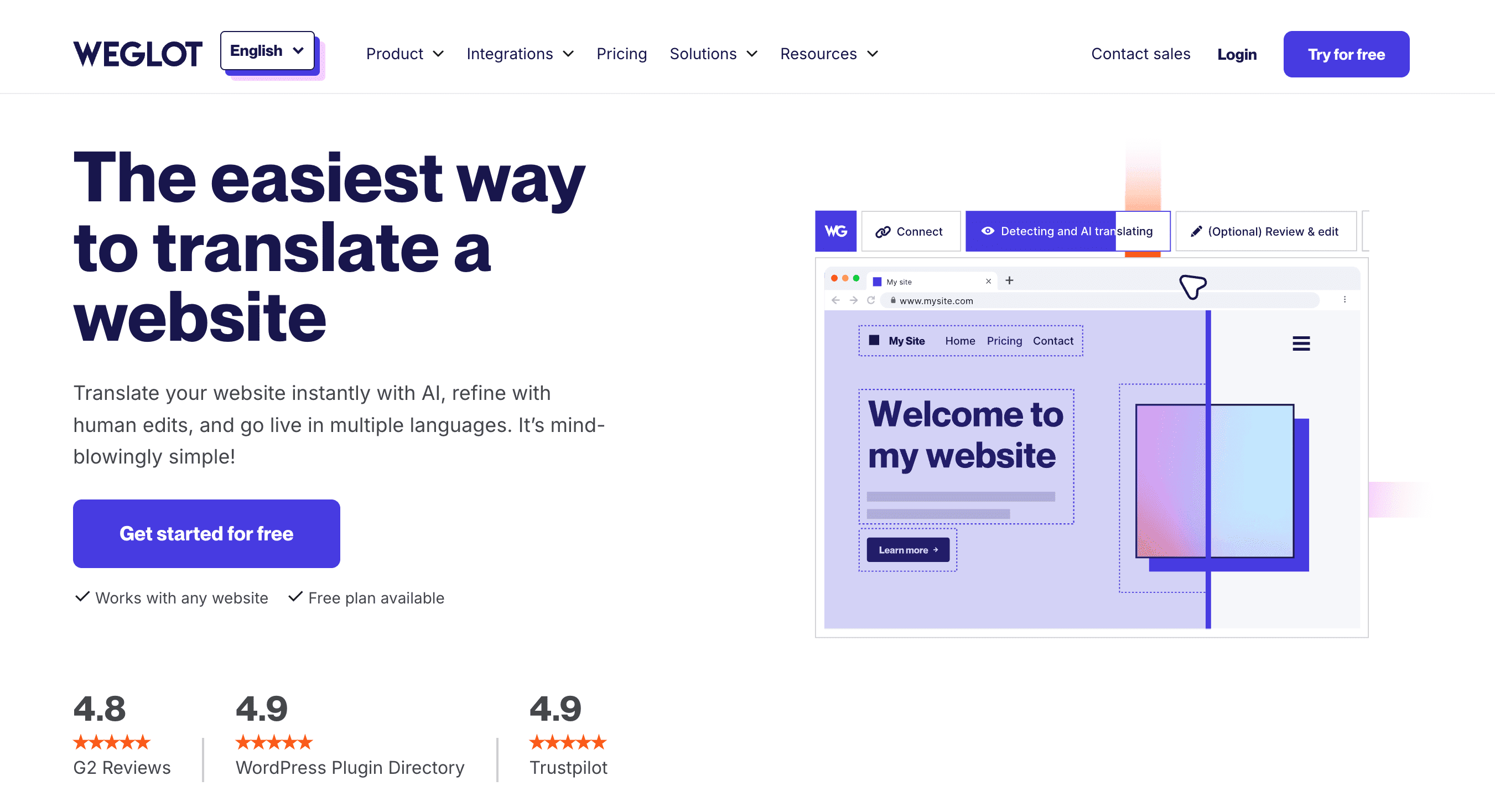
Source: Weglot
- You can also add Ahrefs, Semrush, or any other SEO tool to do proper keyword research for your location.
- Also, add hreflang tags to guide search engines and avoid duplicate content issues. It basically helps search engines serve the right language version to the right users.
Just these three will be a good start.
For larger businesses
Enterprises, obviously, need a different system:
- You can use Lokalise or Smartling. These are enterprise-level translation systems that manage content across dozens of languages.
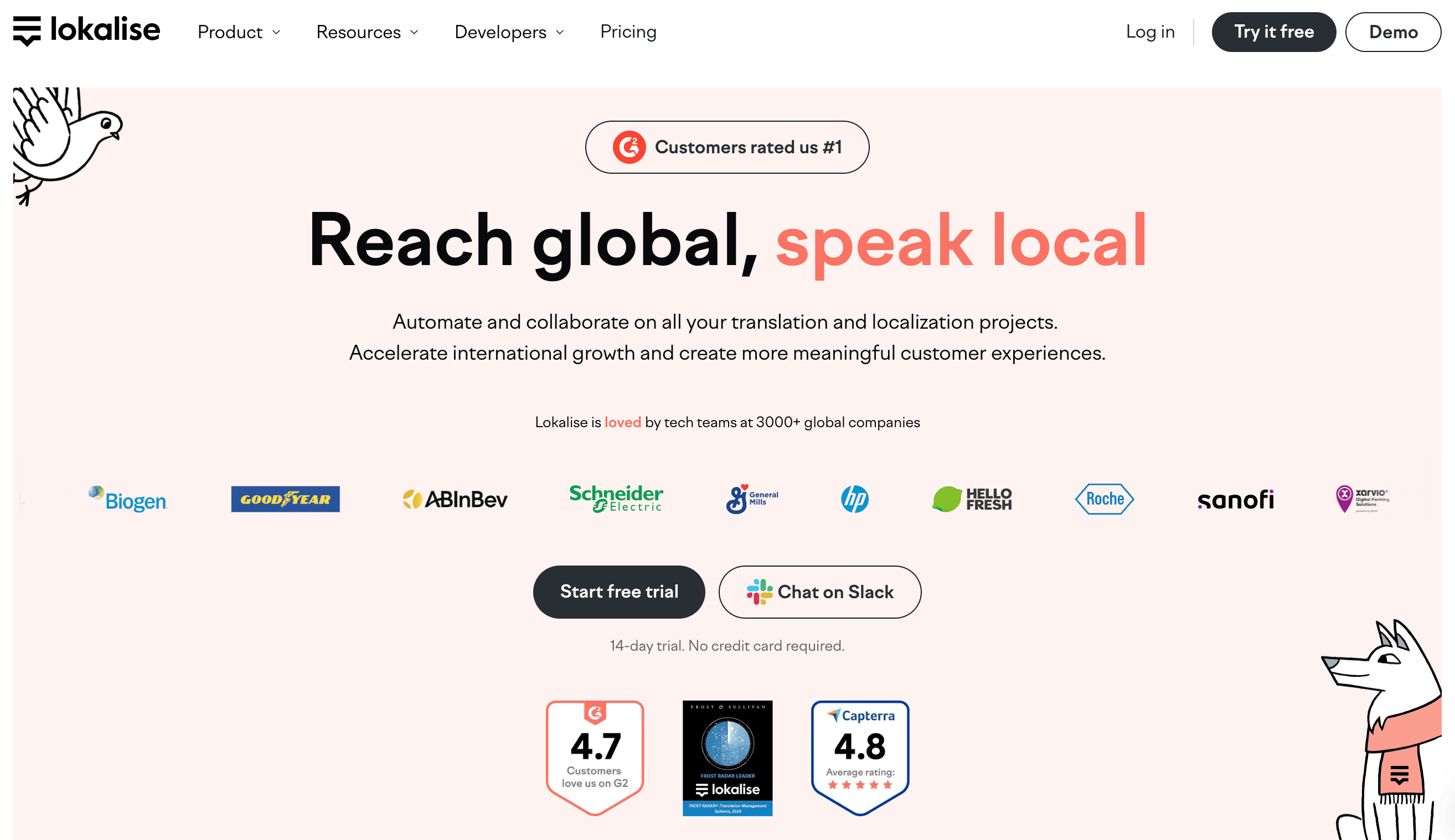
Source: Lokalise
- But technology... isn’t enough. The best SEO strategies include working with local specialists. They understand cultural nuance and how competitors optimize in their region.
- Overall, make sure you do your research both in terms of the cultural aspects and from the SEO perspective. For this, you will likely need local experts.
But even if you don’t have time to go into every single detail, at least go over some basics. You will thank yourself later when you see this research result in great local search volume.
For everyone
No matter your size, there’s one universal rule: local authority matters. Backlinks from regional sites, directories, and publications act as proof of trust to search engines. Without them, even the best localized content can struggle to rank.
Conclusion
Now, you know that all this localization SEO vs. SEO translation battle isn’t really a battle. Both work for search engine optimization when expanding into international markets. You just need to understand how and when to use each.
After reading this guide, you’re well-equipped.



